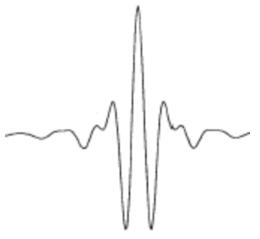
ME 252 B
Computational Fluid Dynamics:
Marie Farge1 & Kai Schneider2

Winter 2004
University of California, Santa Barbara
1 LMD-CNRS, Ecole Normale Supérieure 2 CMI, Université de Provence
24 rue Lhomond 39 rue Joliot-Curie
75231 Paris Cedex 05, France 13453 Marseille Cedex 13, France
Email mailto:farge@lmd.ens.fr Email : mailto:kschneid@cmi.univ-mrs.fr
http://wavelets.ens.fr/ http://www.l3m.univ-mrs.fr/schneider.htm
Courses: Monday / Wednesday / Friday 9.00 am – 9.50 am, GIRVETZ 2123
Office hours: Tuesday / Thursday 4.00 pm – 5.00 pm, Engineering II, room 2332
Objectives of the course
Our goal is to bring the students to a level of understanding which allows them to apply wavelet methods to solve their own problems. To guarantee a good assimilation of the wavelet theory, we will first recall the Fourier transform and the most important mathematical theorems related to it. We will then provide the students with a basic knowledge of wavelets, for both the continuous wavelet transform, the orthogonal wavelet transform and the wavelet packet transform, without going too far into their mathematical background. We will give the basics concerning their numerical implementation and illustrate their use with academic examples. We will illustrate the course with applications to signal and image processing, data compression, denoising and resolution of PDEs, focusing in particular to applications in turbulence.
Content of the course
Fourier integral and Fourier series, academic examples.
Properties, Parseval's theorem, convolution. Uncertainty principle,
Brillouin's information plane.
Auto-correlation function, spectrum, Wiener-Khinchin's theorem.
Discrete Fourier transform, Shannon's sampling theorem, fast Fourier transform.
Applications for analyzing the global regularity of a function, for filtering and denoising signals and images.
Definitions, academic examples.
Information plane, choice of the mother wavelet.
Properties, Parseval's theorem, reproducing kernel.
Boundary effects, algorithms.
Scalogram and its relation to spectrum and structure functions.
Extension to two and three dimensions.
Discretization of the wavelet space, quasi-orthogonal representations, wavelet frames.
Orthogonal wavelet bases, properties, academic examples.
Quadrature mirror filters, multi-resolution analysis.
Fast wavelet transform algorithm.
Biorthogonal wavelets, wavelets on the interval.
Extension to two and three dimensions.
Applications for compressing and denoising signals and images.
Wavelet packets and Malvar wavelets orthogonal bases.
Information plane, information cost, information entropy.
Theoretical dimension of the representation, choice of the best basis.
Fast wavelet packet transform algorithm.
Extension to two and three dimensions.
Applications
for compressing and denoising signals and images,
comparison with
wavelets.
Wavelets and operator equations.
Norm equivalences and preconditioning of matrices.
Nonlinear approximation, adaptive grids, and error estimates.
Adaption strategy for evolution problems.
Compression of operators (BCR algorithm).
Evaluation of nonlinear terms, conncection coefficients, collocation on adaptive grids.
Operator adapted wavelets (biorthognal decompositions and vaguelettes).
Definition and properties of turbulence.
Statistical theory of two-dimensional and three-dimensional turbulence.
Intermittency and coherent structures.
Wavelet
analysis of turbulent signals from both laboratory and numerical
experiments using continuous and orthogonal wavelets.
Extraction
of coherent structures in one, two and three dimensional turbulent
flows,
and comparison between wavelets, wavelet packets and
Malvar wavelets.
Resolution of the incompressible Navier-Stokes equations using orthogonal wavelets.
Coherent
Vortex Simulation (CVS), based on nonlinear wavelet filtering,
and
comparison with Large Eddy Simulation (LES), based on linear Fourier
filtering.
Lecture on Fourier transform and sampling : Fourier transform
Lectures on continuous wavelet transform: Continuous wavelet transform 1d
Continuous wavelet transform 2d
Lectures on orthogonal wavelet transform: Discrete wavelet transform 1d
Lectures on wavelet packet transform: Wavelet packet transform
Excercices
Sheet 1 : ucsb_ex1.pdf due to January 14th
Sheet 2 : ucsb_ex2.pdf due to January 30th
Sheet 3 : ucsb_ex3.pdf due to February 13th
Additional material
Marie
Farge and Kai Schneider, 2002
Analysing and compressing
turbulent fields with wavelets
Note IPSL, n°20, April
2002 pdf-file
Marie Farge, 1992
Wavelet transforms and their applications to turbulence.
Ann. Rev. Fluid Mech, 24:395-457, 1992 pdf-file
Barbara Burke, 1996
The world according to wavelets.
Stephane Mallat, 1999
A wavelet tour of signal processing.
Paul S. Addison, 2002
The illustrated wavelet transform handbook.
Institute of Physics (IOP)
Stephane Jaffard, Yves Meyer and Robert D. Ryan, 2001
Wavelets: tools for science and technology.
M.V. Wickerhauser, 1994
Adapted wavelet analysis from theory to software.
Wavelet application in cosmetics
Last update 31.1.2004 Webmaster